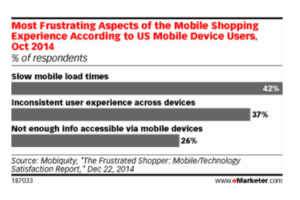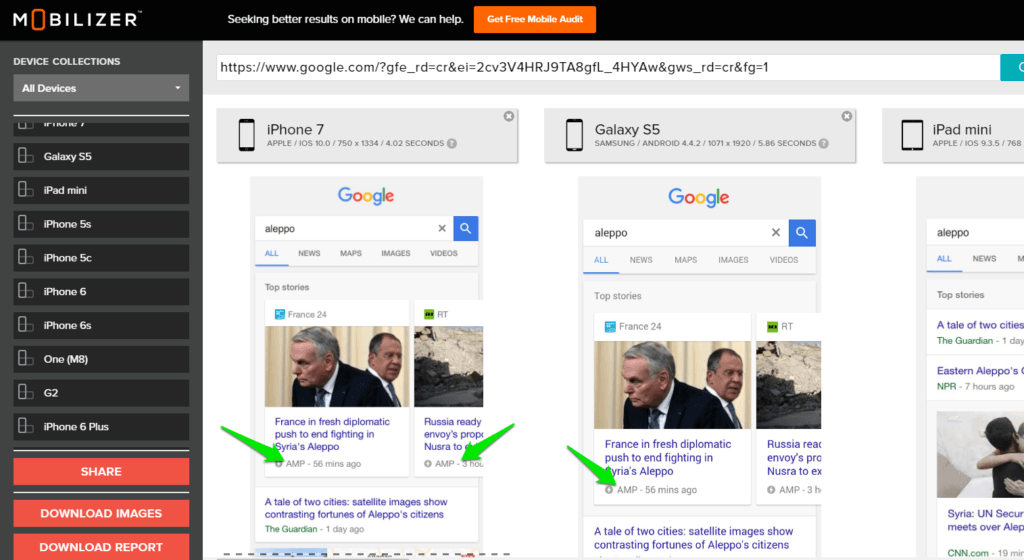Need to speed? Click here to jump directly to our top 5 reasons.
What’s AMP?
AMP stands for Accelerated Mobile Project. An open-source project guided by Google, AMP aims to increase the velocity at which web pages load on your phone. Initiated in October 2015, AMP is already bearing fruit, enabling websites to break through speed limits and deliver their results at full throttle.
Certainly, consumer demand for speed and an enhanced user experience is the foremost reason driving AMP. But as I will explain, AMP also enhances your mobile SEO, ad monetization, and conversion rates too – all critical to exploiting the mobile web’s ability to deliver immediate connection, engagement and information.
The Mobile Mantra: Get What You Need and Get It Now
Mobile’s foremost dominant trait is immediacy. Technology, foremost the mini computers in our hip pockets, is dissolving the space and time separating us into an ever-present now of instantaneous connections, information and resources – all faster than Usain Bolt can dash the 100-meter sprint.
In fact, the average US consumer consults their phone a spectacular 150 times a day – all in short bursts of hyperkinetic information-seeking activity. Each web session typically lasts just over one minute and then we are off, vigorously seeking our goal.
That demand for instantaneous access no matter where you are or what you are doing explains AMP. Because if we consumers have any single obvious frustration with the mobile web, it’s the slowness with which mobile pages load.
Recognizing this burdensome yet fixable irritant, Google and partners have launched AMP to get mobile load time up to speed.
Technically Speaking, What’s AMP?
AMP is built upon AMP HTML, a new open coding framework that is created entirely out of existing web technologies with a focus on building light-weight webpages. For a quicker load time, AMP slims your pages load down to the basics by trimming HTML tags and reducing rendering.
A second core aspect of the project is Google AMP Cache or Content Delivery Network, which stores web pages for fast loading at near instantaneous speeds. More specifically, the AMP Cache is a proxy-based global content delivery network for all valid AMP documents. It grabs AMP HTML pages, caches them, and delivers them in fractions of a second, while also automatically elevating page performance.
Mobile1st offers mobile optimization services to increase your mobile website’s revenue/conversion by decreasing your shopping cart abandonment rate, reducing your page load speed, improving mobile UX and SEO, analyzing your mobile analytics, and more. Our team of mobile experts analyzes your website across 35+ factors, A/B tests ideas, and can even (optionally) implement the design/code improvements.
Get a mobile audit of your website today!
5 Reasons Why You Need AMP
1. Mobile Speed Is Crucial for Conversion
In this speed-addicted world, a slow Internet is a distinct irritant, a bothersome pea under the mattress of the ever-so-dainty consumer.
Consumers, in fact, are shockingly impatient. Already in 2010, most mobile users petulantly declared they would depart a website if forced to wait beyond a mere three seconds. If you want to please your mobile visitors, make three ticks of the clock your maximum load time. Each additional second’s delay, warns Radware, reduces conversions rates by 7%.
But today, websites still average a shocking 19 seconds to load on mobile, reports Google. If that time can be sliced to five seconds, they estimate, revenues will double.
2. Increase Mobile User Experience
“Any delay longer than a second will cause the user to interrupt their flow of thought, creating a poor experience.”Google
Beyond issues of immediate sales conversions, load speed is critical to your website’s UX and can drive customer perceptions of your brand. According to Mobiquity, the leading complaint for mobile shoppers is slow load times (42%). Of course, delivering a satisfying user experience is essential in this era of intense competition and brand differentiation based on customer experience. In fact, 79% of shoppers who are dissatisfied with a website’s performance, report they are less likely to return.
Once implemented, AMP and its revved-up content delivery can propel impressive displays of increased user satisfaction. In 2015, the Washington Post deployed AMP to enhance its load time, and the number of mobile readers that returned to its site within the week jumped by an impressive 23%.

Chart courtesy of eMarketer
But why is Google so preoccupied with AMP? Google’s close to $75 billion in annual advertising revenues depends deeply of course on the mobile web. But the increasing addiction of consumers to apps limits Google’s ability to serve up search results and deliver advertising. Confronting such potent competitors as Facebook and its in-app advertising revenues, Google desperately wants to elevate consumer satisfaction and delight with the mobile web. In fact, Google itself strives for a load time of a mere one second.

3. AMPed-Up Mobile SEO?
Google has always proclaimed that satisfying users is its #1 goal, through delivering relevant, useful search results. Will Google take into account AMP implementations in its search rankings?
Certainly, Google is already highlighting news stories, cooking recipes, and other content from websites employing AMP, as the above phone screenshots demonstrate. AMP-lified websites are prominently featured at the start of targeted search results, often in a carousel display. But Google has also announced that websites implementing AMP implementations in the near future may get a boost in organic rankings.
Finally AMP may twist SEO results in a more subtle fashion. After all, Google already incorporates considerations of user satisfaction and page load speed into its algorithm, drawing on such metrics as bounce rate. AMP promises to reduce your load time and the rate at which visitors bounce away in frustration at slow loading. That in turn will surely impact Google’s ranking of your website.
“You shouldn’t be surprised to find AMP pages ranking higher than non-AMPs.”Neil Patel, KISSmetrics
4. Better Monetization of Ad Displays
On July 19, Google’s VP of Analytics and Display, Paul Muret, announced the expansion of AMP to advertisements. AMP will now accelerate the load time of the ads that often accompany content publishers’ web pages, helping those websites monetize their pages with third-party ads.
The AMP HTML ads load almost instantaneously. Already a growing number of the most prominent ad networks are using the AMP-ad extended component. The rapid loading of AMP ads promises an additional benefit – it will help reduce the use of ad blockers by consumers who are frustrated with slow-appearing ads as they wait for their desired content.
5. Analytics done Right – Eliminating Redundancies
The developers at AMP of know that analytics is a critical tool. By measuring audience interactions, analytics enable marketing and web teams to comprehend their users and their behavior. And understanding your mobile visitors is at the heart of providing useful content, elevating engagement, building loyalty and improving the bottom line.
But analytics have a downside.
Typically, multiple tags from multiple analytic tools are implemented on each page. This proliferation leads to degraded performance, as each tracker adds its small weight to the total page weight and loading time — adding up to a second-rate user experience.
AMP Analytics instead adopts the best practice of “measure once, report to many.” Only one set of tags is installed to report to multiple analytics tools, thus eliminating the time drag of duplicate tags and boosting UX.
AMP today is adopted by leading news and retail outlets worldwide, including 8 million sales pages on eBay. Cutting your load time down to an acceptable five seconds from the average mobile load of 19 seconds (on 3G networks) has been demonstrated to:
- Boost ad viewability by 25%
- Extend average session lengths by two-thirds
- Cut bounce rate by one third
- Double their ad revenue
Isn’t it time you too seized the advantages offered by a speeded-up mobile web?
- Google’s AMP: Enemy or Ally to Your Mobile Friendly Website? - January 29, 2018
- Mobile Marketing: Optimize the Mobile Customer Journey - January 29, 2018
- Mobile Load Time: Increasing Mobile Page Speed to Improve Mobile Conversion - January 22, 2018

